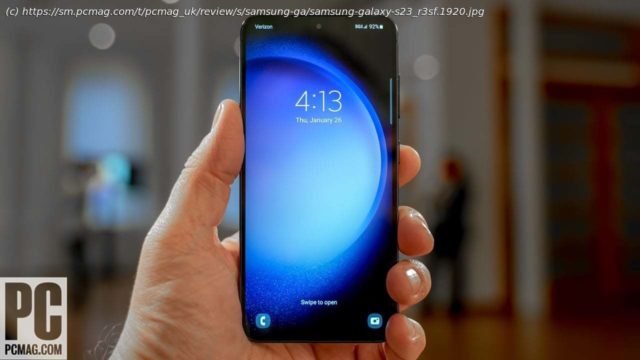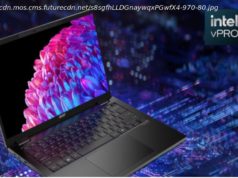The smallest member of the S23 family is plenty powerful
The Samsung Galaxy S23 (starting at $799.99) is a compact phone that features most of the same high-end specs and performance of its stablemates, the medium-sized Galaxy 23+ (starting at $999.99) and the gargantuan Galaxy S23 Ultra (starting at $1,199.99). The S23 offers better battery life than its predecessor, along with the most power you can get in a „small“ Android phone. Slower charging speeds and a lack of ultra-wideband support keep it from truly competing with its larger S23 siblings, but it’s a welcome alternative to the small-hand-friendly Apple iPhone 14 ($799) and Google Pixel 7 ($599). For Smaller Hands
The Galaxy S23, which measures 5.8 by 2.8 by 0.3 inches (HWD) and weighs 5.9 ounces, is noticeably smaller than the S23+ (6.2 by 3.0 by 0.3 inches, 6.9 ounces) and the Pixel 7 (6.1 by 2.9 by 0.3 inches, 6.9 ounces), but is about the same size as the base iPhone 14 (5.8 by 2.8 by 0.3 inches, 6.07 ounces). The OnePlus 11 5G is larger and heavier (6.4 by 2.9 by 0.3 inches, 7.2 ounces).
Despite its smaller stature, the S23 still has the same premium design and build quality as its larger siblings. It features Gorilla Glass Victus 2 panels on the front and back, and Samsung’s Armor Aluminum chassis provides additional protection in between. It carries an IP68 rating, which means it can survive a dunk in water up to five feet deep for up to 30 minutes.
Design-wise, the S23 is a scaled-down version of the S23+. In fact, only size separates the phones‘ appearance. The S23 Ultra, meanwhile, is an entirely different beast with a more angular design and an S Pen slot. You can pick one of six colors: Cream, Graphite, Green, Lavender, Lime, or Phantom Black. The Graphite and Lime options are exclusive to Samsung.com, but the others should be widely available at retail.
We’re big fans of the matte finish on the back, which doesn’t attract fingerprints or feel slippery. The camera module looks good, too; each camera gets an individual lens, whereas the whole stack jutted out on older models. The camera bar of the Pixel 7 looks ostentatious by comparison.
The phone includes a volume rocker and power button on the right side, but the top and left are bare. A SIM card slot, a USB-C port, and one of the two speakers are on the bottom; the other speaker is positioned at the very top of the phone’s face where the glass and metal frame meet.
Samsung offers two biometric security methods—facial recognition and an in-display fingerprint scanner. The fingerprint scanner worked faster than fingerprints in testing and we had no issues with reliability. Samsung says the face scanner is less secure than the fingerprint reader, however.A Premium Screen
Despite its smaller 6.1-inch AMOLED screen, the S23 has the same 2,340-by-1,080-pixel (FHD+) resolution as the 6.6-inch S23+. That means the S23 has a higher pixel density of 425ppi, compared with 393ppi on the S23+. The Google Pixel 7’s 6.3-inch screen offers 2,400 by 1,080 pixels for a density of 418ppi.
The screen is more than bright enough, with 1,200 nits typical and 1,750 nits peak outdoor brightness. You shouldn’t have any problem seeing it clearly even under direct sunlight. For comparison, the Pixel 7 has 1,000/1,400 nits and the iPhone 14 has 800/1,200 nits. Viewing angles on the Galaxy S23 are quite good and colors appear vibrant thanks to the screen’s wide contrast ratio and HDR10+ support.
Like many modern flagship phones, Samsung offers a variable refresh rate that dynamically scales between 1Hz and 120Hz depending on what you’re doing. The high refresh rate enables smooth scrolling and gameplay, while the lower rate consumes less power and helps improve battery life.
As is typical of most Android flagships, there’s a selfie camera near the top edge of the screen. However, it doesn’t look bad in light of the nearly bezel-free design.Minimal Performance Compromises
Thankfully, much of what makes the Galaxy S23+ a performance standout is present in the S23, including the stellar Qualcomm Snapdragon 8 Gen 2 for Galaxy chip. Highlights of this processor include a 4nm process and an octa-core Kryo CPU with a single Arm Cortex-X3 core at up to 3.36GHz, four performance cores at up to 2.8GHz, and three efficiency cores at up to 2.0GHz. It also has an Adreno 740 GPU.
It offers the same amount of RAM (8GB) as the S23+, but storage options and specs differ. You can get the S23 in 128GB (UFS 3.1), or 256GB and 512GB (UFS 4.0) configurations; the S23+ is available only with the latter two configurations (there no microSD card slot in either model).






